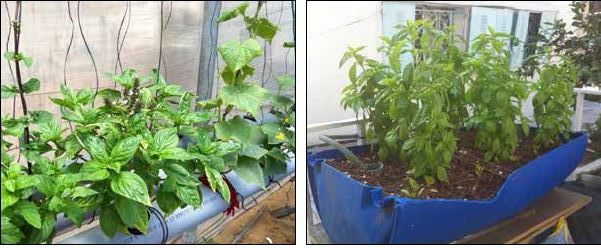BASIL
pH: 5.5-6.5
Plant spacing: 15-25 cm (8-40 plants/m2)
Germination time and temperature: 6-7 days with temperatures at 20-25 °C Growth time: 5-6 weeks (start harvesting when plant is 15 cm)
Temperature: 18-30 °C, optimal 20-25 °C
Light exposure: Sunny or slightly sheltered
Plant height and width: 30-70 cm; 30 cm
Recommended aquaponic method: media beds, NFT and DWC

Growing basil in aquaponic units: Basil is one of the most popular herbs to grow in aquaponic units, particularly in large-scale commercial monoculture units because of its high value and the high demand in urban or peri-urban zones. Many cultivars. of basil have been tried and tested in aquaponic units including the Italian Genovese basil (sweet basil), lemon basil, and purple passion basil. Owing to the higher nitrogen.
uptake, basil is an ideal plant for aquaponics; however, care should be used to avoid excessive nutrient depletion of the water.
Growing conditions: Basil seeds need a reasonably high and stable temperature to initiate germination (20-25 °C). Once transplanted in the units, basil grows best in warm to very warm conditions and full exposure to sun. However, better quality leaves are obtained through slight shading. With daily temperatures higher than 27 °C plants should be ventilated or covered with shading nets (20 percent) during strong solar radiation seasons to prevent tip burn.
Growing instructions: Transplant new seedlings into the aquaponic unit when the seedlings have 4-5 true leaves. Basil can be affected by various fungal diseases, including Fusarium wilt, grey mould, and black spot, particularly under suboptimal temperatures and high humidity conditions. Air ventilation and water temperatures higher than 21 °C, day and night, help to reduce plant stress and incidence of diseases.
Harvesting: The harvest of leaves starts when plants reach 15 cm in height and continues for 30-50 days. Care should be used when handling leaves at harvest to avoid leaf bruising and blackening. It is advisable to remove flowering tips during plant growth to avoid bitter tastes in leaves and encourage branching. However, basil flowers are attractive to pollinators and beneficial insects, so leaving a few flowering plants can improve the overall garden and ensure a constant supply of basil seeds. Basil seeds are a speciality product in some locations.